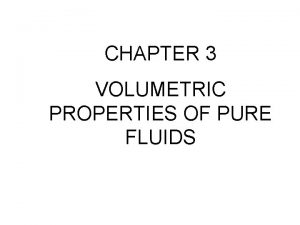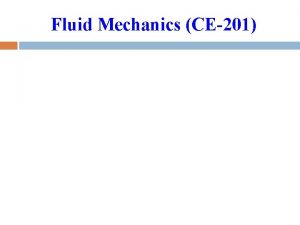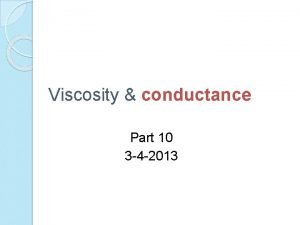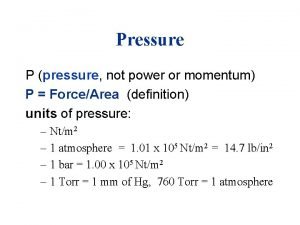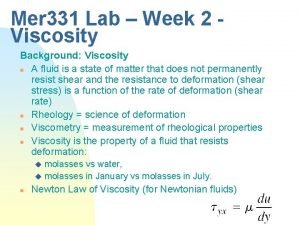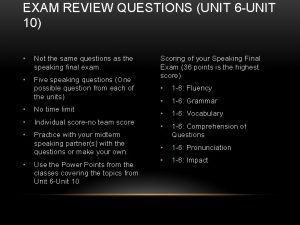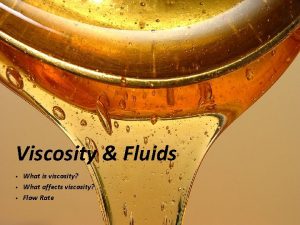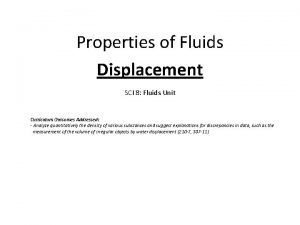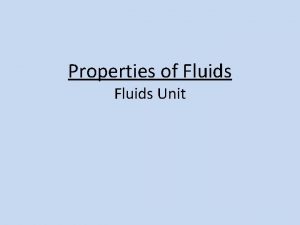Properties of Fluids Viscosity SCI 8 Fluids Unit













- Slides: 13

Properties of Fluids Viscosity SCI 8: Fluids Unit Curriculum Outcomes Addressed - Design an experiment to test the viscosity of various common fluids and identify the major variables (208 -6) - Compare the viscosity of various liquids (307 -6) - Describe factors that can modify the viscosity of a liquid (307 -7) - Use a temperature-measuring technology effectively and accurately for collecting data in temperature-viscosity investigations (209 -3) - Demonstrate a knowledge of WHMIS standards by demonstrating the correct methods of disposal of various oils, for example (209 -7) - Identify and relate personal activities and potential applications to fluid dynamics (109 -10, 112 -7, 210 -12)

• We will study the following properties of fluids: 1. Density 2. Buoyancy (Floating and Sinking) 3. Displacement (Archimedes’ Principle) 4. Viscosity 5. Pressure (Pascal’s Principle)

Key Terms • Viscosity: “ A fluid’s resistance to flow. ” • Viscous: “Having a thick, sticky consistency between solid and liquid; having a high viscosity. ”

What is Viscosity? • Viscosity is the physical property of a fluid that limits ability to flow • Viscosity only applies to fluids (liquids and gases) because solids do not flow. • The higher a fluid’s viscosity, the slower it flows. • The lower a fluid’s viscosity, the easier/faster it flows. In this example, viscosity increases from left to right (left has lowest viscosity, right has highest viscosity)

What Causes Viscosity? • A fluid’s viscosity depends on its internal friction or strength of particle bonds. • If the bonds between a fluid’s particles are strong, then viscosity is high, which means there is high resistance to flow, and the fluid does not flow easily (flows slowly). • If the bonds between particles are weak, then viscosity is low, which means there is low resistance to flow, and the fluid flows easily (flows quickly)

Practice Questions 1) If a fluid flows very slowly, what can you say about its viscosity? Is this fluid viscous or not viscous? 2) If a fluid flows very easily/fast, what can you say about its viscosity? Is this fluid viscous or not viscous?

Practice Questions - ANSWERS 1) If a fluid flows very slowly, what can you say about its viscosity? Is this fluid viscous or not viscous? A fluid that flows slowly has a high viscosity. We would say that this fluid is viscous. 2) If a fluid flows very easily/fast, what can you say about its viscosity? Is this fluid viscous or not viscous? A fluid that flows easily/fast has a low viscosity. We would say that this fluid is not viscous.

Practice Questions 3) Name three liquids that have a high viscosity. 1. 2. 3. 4) Name three liquids that have a low viscosity. 1. 2. 3.

Practice Questions - ANSWERS 3) Name three liquids that have a high viscosity. 1. Molasses 2. Maple Syrup 3. Motor Oil 4) Name three liquids that have a low viscosity. 1. Water 2. Vegetable Oil 3. Pop

Order of Viscosity • Order the following liquids from least to most viscous (at room temperature): – Molasses – Honey – Water – Window Putty – Maple Syrup – Anti-Freeze – Blood – Shortening – Peanut Butter – Ketchup – Motor Oil

Order of Viscosity - ANSWER • Order the following liquids from least to most viscous • Centipoise: The unit of dynamic viscosity in the centimetre gram second system (how many cms 1 gram of a fluid flows per second) MATERIAL APPROXIMATE VISCOSITY (in centipoise) Water Blood Anti-Freeze Motor Oil or Maple Syrup Honey Molasses Ketchup Peanut Butter Shortening Window Putty 1 to 5 10 15 150 to 200 2, 000 to 3, 000 5, 000 to 10, 000 50, 000 to 70, 000 150, 000 to 250, 000 1, 000 to 2, 000 100, 000

The Pitch Drop Experiment: The Highest Viscosity in the World http: //www. smp. uq. edu. au/content/pitch-drop-experiment

Viscosity and Temperature • How might the viscosity of a fluid be affected by temperature? Make a two-sentence prediction by filling in the blanks below. As temperature increases, viscosity ________. As temperature decreases, viscosity ________.
 Buoyancyability
Buoyancyability Volumetric properties of pure fluids
Volumetric properties of pure fluids Unit viscosity
Unit viscosity Falling sphere redwood and ostwald are the type of
Falling sphere redwood and ostwald are the type of Specific volume units
Specific volume units Viscosity measurement unit
Viscosity measurement unit Viscosity formula
Viscosity formula Unit of viscosity
Unit of viscosity Unit of viscosity
Unit of viscosity Unit of viscosity in si system
Unit of viscosity in si system Coanda effect equation
Coanda effect equation Unit 6 review questions
Unit 6 review questions Define viscosity
Define viscosity Viscosity si units
Viscosity si units

